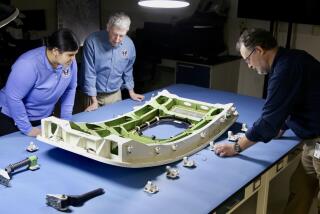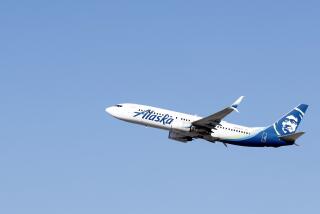Jet Crash Adds Urgency to Issue of Inspecting Composite Parts
WASHINGTON — Fighter jets built for the Pentagon are routinely inspected with ultrasound to detect hidden flaws that may develop in lightweight composite materials used to make such critical parts as the wings and tail.
But only visual maintenance inspections were required for the Airbus A300 jetliner that crashed last month in New York after its composite tail fin broke off.
The adequacy of visual inspections has become a focus of the National Transportation Safety Board’s investigation into the Nov. 12 crash of American Airlines Flight 587, a source close to the probe said. Composite materials can be weakened by internal failures that are not visible on the surface.
Adding to the concerns is the fact that the tail fin had a flaw that was fixed before the plane was put into service. Some engineers who work with composites say that condition should have warranted more than regular visual inspections.
“As a passenger on a plane built with composites, I personally would feel much more secure knowing that the structures received periodic inspection with ultrasound,” said Lee McKague, a Fort Worth engineer with more than 30 years of experience with composites, mainly with military and aerospace contractors.
The NTSB has not determined what caused the crash in which 265 people died. It is the first major civil aviation accident involving the failure of a key component built of composites. The investigation ultimately may lead to new government standards for inspecting and repairing composite components on airliners. Recommended methods vary among manufacturers, and the Federal Aviation Administration has approved a variety of techniques.
After the success of military designers, builders of commercial aircraft are making greater use of composites in stress-bearing structures. The advanced material is created by molding together many individual sheets of carbon fibers that are embedded in a special epoxy resin. Composites are lighter and stronger than most metals, but their stiffness can be compromised by internal flaws that are invisible to the eye.
Ultrasound inspection of composites is more costly and time-consuming than visual checks, but engineers say it is also more revealing. Ultrasound relies on sound waves to generate an image of the internal condition of an object; a similar technology is used in doctors’ offices to monitor pregnancies.
“If we had a question about a composite structure, we would inspect it ultrasonically,” said Mike Thomas, manager of laser ultrasonic testing for Lockheed Martin Corp., which is building the government’s new F-22 Raptor fighter jet. “Ultrasound is the standard method of looking at composites.” The company has developed a technology that combines lasers and ultrasound to simplify inspections.
Many industry experts also question the usefulness of a recent FAA directive calling for inspections of the tail fins of similar A300 and A310 jets after the Flight 587 crash. The FAA ordered visual inspections, not ultrasonic; no problems have turned up.
“I’m always a little leery of visual inspections only on composites,” said Ronald Bucinell, a professor of mechanical engineering at Union College in Schenectady, N.Y. “I don’t think they tell enough of the story.”
Airbus spokesman Mark Luginbill said the company recommends a visual inspection of the composite tail fin every five years, as part of a scheduled heavy maintenance check. A source close to the investigation said American Airlines followed Airbus’ recommendations on the plane that crashed. The tail fin was last checked visually in December 1999. No problems were found.
Luginbill said Airbus also conducts an ultrasound inspection on composite parts before an aircraft is put into service. “We’re very comfortable with our manufacturing and inspection process,” he said. Other manufacturers rely on similar inspection methods. Airbus, a European consortium, is one of the world’s top makers of commercial jets.
But several engineers said ultrasound inspections during maintenance could have been particularly valuable in the case of the plane that crashed, because a flaw had been discovered in the composite material before the aircraft was put into service in 1988.
The flaw was a “delamination,” meaning that some layers of the composite material had come apart. Engineers say that, in a new part, a delamination is usually a sign of a problem in the manufacturing process.
Once a component has gone into service, delaminations develop usually because of an impact during flight or maintenance. Hailstorms or tools dropped on a surface can cause problems. If a delamination begins deep in the layers of the material, it isn’t readily visible.
With delamination, the layers of the composite separate like pages of a book, weakening the material and reducing its ability to bear stress. When a book is closed and standing upright, its pages can easily support the weight of a nickel. But if those pages are ruffled open, at some point the coin will drop.
The delamination in the American Airlines plane was found in one of six attachment points that connected the tail fin to the main fuselage. The NTSB said technicians repaired the problem at the time, following established procedures. No additional inspections were deemed necessary beyond the standard visual check every five years.
Now investigators are trying to determine whether the fix may have played a role in the failure of the tail fin.
Arum Kumar, who heads Seal Laboratories in El Segundo and is recognized by the FAA as an expert in failure analysis of composites, said the repair could have made one attachment point stronger than the other five.
“That would have shifted the load to the other points, putting more load on them than they were designed for,” Kumar said. “It’s hard to repair composites. Generally, you replace them.”
McKague concurred: “That is alarming to me. There should not be any reason for a manufacturing defect on a scale that requires repair. I would want to understand why the defect occurred and how one could be assured it wasn’t evidence of a weakness that would spread with loading.”
Often, major accidents are the result of a combination of factors. Investigators are looking at everything from the design of the aircraft to the turbulence it encountered after takeoff to the actions of the pilots. Meanwhile, the tail fin has been shipped to NASA’s Langley Research Center in Virginia for intensive analysis. Langley specializes in advanced aerospace materials such as composites.
“As composites are being used more and more, it’s not surprising that we’re looking at something that happened with a structure that had composites in it,” said Mark Shuart, director of structures and materials at Langley.
Although the investigation is expected to continue for months, the crash renewed debate within the aviation industry about how to improve and standardize inspection and repair of composite materials.
“While metals are much better understood, we are still growing up when it comes to this field of composites,” said Ed Wen, an engineer at Aurora Flight Sciences of West Virginia, which manufactures composite parts for military aircraft.
The crash of Flight 587 “is going to change the whole subject of inspection of composites,” Wen added. “Obviously, we have to do much more rigorous inspections.”
Until recently, ultrasonic inspection has been tedious and expensive. Typically, it involved using water or a gel to transmit the sound waves. Parts with irregular shapes were difficult to inspect, and major components often had to be taken off an airplane for the process.
But Lockheed Martin has developed a technique that uses lasers to generate an ultrasonic signal, eliminating the need for water and making inspections faster, more thorough and less expensive.
Known as Laser UT, it is being used for factory inspection of advanced fighter aircraft that are subject to much greater stresses in flight than commercial airliners. The ultrasound images generated during factory inspections can be stored and later compared with the results of maintenance inspections in the field.
The Air Force is exploring ways to add Laser UT to its maintenance depots, where aircraft are now inspected using less sophisticated hand-held ultrasonic probes.
“It is a health monitor for the aircraft once it gets into service,” said Thomas, the Lockheed manager. “We’ve got a whole regime of things that can happen, from bird strikes to battle damage. Now we are able to establish a baseline for an aircraft during manufacturing and monitor it over time for any changes.”
More to Read
Inside the business of entertainment
The Wide Shot brings you news, analysis and insights on everything from streaming wars to production — and what it all means for the future.
You may occasionally receive promotional content from the Los Angeles Times.










